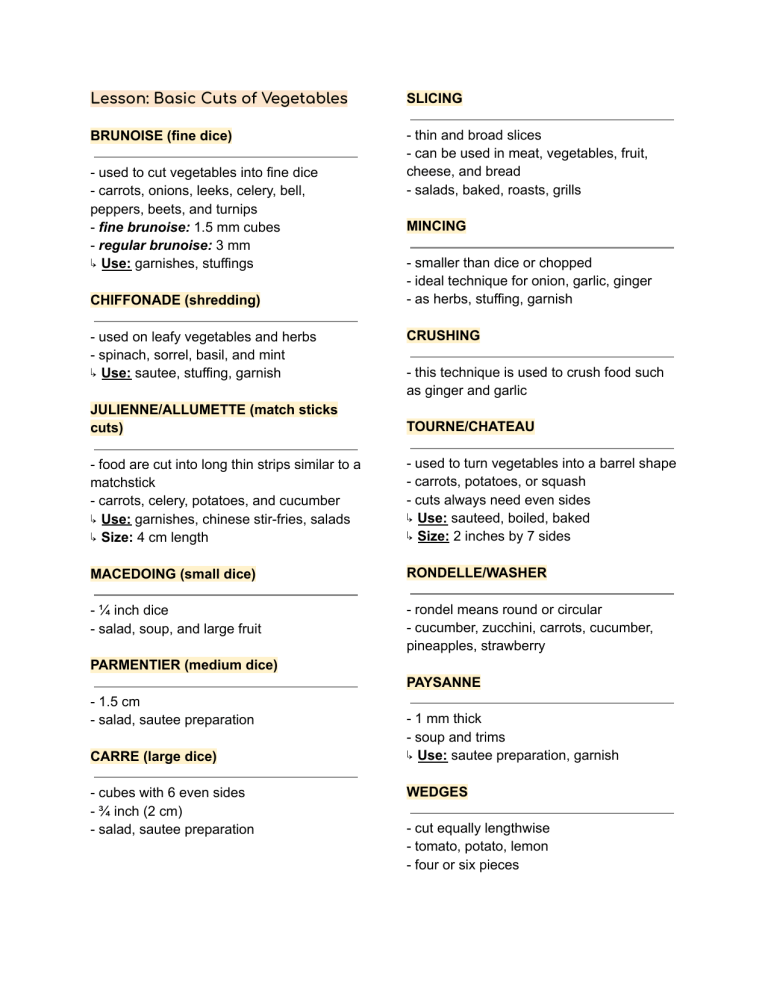
Lesson: Basic Cuts of Vegetables SLICING BRUNOISE (fine dice) - thin and broad slices - can be used in meat, vegetables, fruit, cheese, and bread - salads, baked, roasts, grills - used to cut vegetables into fine dice - carrots, onions, leeks, celery, bell, peppers, beets, and turnips - fine brunoise: 1.5 mm cubes - regular brunoise: 3 mm ↳ Use: garnishes, stuffings CHIFFONADE (shredding) - used on leafy vegetables and herbs - spinach, sorrel, basil, and mint ↳ Use: sautee, stuffing, garnish MINCING - smaller than dice or chopped - ideal technique for onion, garlic, ginger - as herbs, stuffing, garnish CRUSHING - this technique is used to crush food such as ginger and garlic JULIENNE/ALLUMETTE (match sticks cuts) TOURNE/CHATEAU - food are cut into long thin strips similar to a matchstick - carrots, celery, potatoes, and cucumber ↳ Use: garnishes, chinese stir-fries, salads ↳ Size: 4 cm length - used to turn vegetables into a barrel shape - carrots, potatoes, or squash - cuts always need even sides ↳ Use: sauteed, boiled, baked ↳ Size: 2 inches by 7 sides MACEDOING (small dice) RONDELLE/WASHER - ¼ inch dice - salad, soup, and large fruit - rondel means round or circular - cucumber, zucchini, carrots, cucumber, pineapples, strawberry PARMENTIER (medium dice) PAYSANNE - 1.5 cm - salad, sautee preparation CARRE (large dice) - cubes with 6 even sides - ¾ inch (2 cm) - salad, sautee preparation - 1 mm thick - soup and trims ↳ Use: sautee preparation, garnish WEDGES - cut equally lengthwise - tomato, potato, lemon - four or six pieces ↳ Use: stew, fried, grilled, roasted, boiled, poached BATON - 1.5 x 5 cm long - 5 mm wide, and 5 mm thick ↳ Use: sautee preparation CULINARY USES - commonly used in food preparation ↳ picking processes, vinaigrettes, and salad dressings - an ingredient in condiments ↳ mustard, ketchup, and mayonnaise - an essential component ↳ chutneys, marinades, and sauces Lesson: Vinegar Facts WHAT IS VINEGAR? HEALTH BENEFITS - comes from the french words vin and aigre (vinaigre) - “sour wine” - composed of acetic acid and water - common sources are grapes and apples 1. Aids in healthy digestion 2. Lowers cholesterol 3. Improves skin health 4. Improves blood pressure 5. Improves immunity Acetic Acid Bacteria: ↳ group of microorganisms with multiple applications in food industry ↳ used for obtaining vinegar, kombucha, cocoa, ascorbic acid, and tartaric acid ↳ involved in spoilage of beer, wine, and cider among fermentation WHERE DOES VINEGAR CAME FROM? - as old as civilization itself - it has been found in Egypt (3000 B.C.) and Babylonian (5000 B.C.) - “poor man’s wine” (posca) - used in many cultures as a condiment and preservative TWO STEPS PROCESS: 1. FERMENTATION ↳ sugars are broken down in the absence of oxygen by yeast 2. ADDITION OF OXYGEN ↳ enables bacteria to produce amino acid, water, and other compounds

